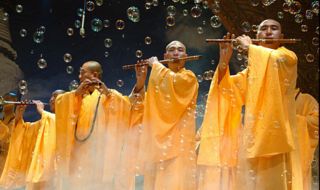|
中国佛教音乐亟待抢救和保护——以五台山佛教音乐为例 |
|
佛教东渐进入中国以来,很快融入中国社会,并成为中国文化的组成部分,甚至在某个历史阶段成为中国文化的主流。在佛教进入中国的同时,佛教音乐也随之而来。但在传播过程中由于语言问题而“金言有译,梵响无授”,因此佛教音乐必然“本土化”。“华化”了的佛教音乐在近两千年的发展过程中,始终植根于中国传统音乐之中并随着中国传统音乐的发展而传承。中国的佛教音乐实际上是中国传统音乐不可分割的组成部分。 “华化”了的佛教音乐从开始就是丰富的,除了有“梵呗”、“转读”、“唱导”等多种诵经形式外,“裁制新声”已成风尚,而且“制无定准”、“师师异法,家家各制”,形成了不同风格的曲调和流派。在传承过程中“虽依拟前宗,而独拔新意”,百花齐放,愈加丰富。尤其在唐代(581--618)及之后,除了僧人们的创作外,宫廷音乐、文人音乐,甚至民间的音乐也被应用的佛教中来,佛教音乐逐渐成为了中国传统音乐的集成地。 在两千年的发展过程中,随着朝代更替,社会形态变化,佛教也随着历史的波澜而起伏。在21世纪的今天,在重视文化多样性、保护民族文化的共识中,我们有必要审视中国佛教音乐的现状,从而更加全面和深刻地认识我们民族的传统音乐及其发展规律。 从20多年来对佛教音乐的调查和对文献资料的研究来看:中国佛教音乐整体上是萎缩了。所谓萎缩,并不是简单的数量上的减少,而是形式、内容等方面的变化。以五台山为例—— 五台山是中国佛教四大名山之首,是全国唯一兼汉传佛教和藏传佛教于一山的佛教圣地。五台山的佛教音乐与中国佛教音乐同步发展,与五台山佛教同兴衰。五台山佛教音乐经历了初始、成型、完善以及衰微的过程。衰微是从民国初开始的,衰微的状况从五台山的数据和数据可以知其大概。 在20世纪80年代中期,搜集到五台山佛教音乐的曲谱本有3种:《宣统本》、《民国本》和《解放本》,这3个谱本的抄写年代分别是宣统二年(1910)、民国二十四年(1935)和1978年。这3本谱本所抄写的曲谱分别是211首、70首和78首。其中《解放本》的抄写者1930年出家,当时是根据他出家时学习的曲调回忆抄写的,因此,《解放本》与《民国本》其实是同一时代的材料。2007年,在对五台山佛教音乐再一次进行调查时,共获得曲调26首。仅从数量看,由211首到78首,再到现在的26首,可以表现出衰微的表面状况。 从佛事形式上看,五台山佛教从元、明之际乐器进入佛事起,就自成一派,也被佛教尊为“北方派”的代表。在五台山中,僧人们则称自己的佛事为“北方佛事”,其唱调也被称为“老北方调”。据僧人们说,“北方佛事”和相对的“南方佛事”主要区别是是否使用乐器伴奏诵经。 “北方佛事”是用乐器伴奏的,并且还有供乐器演奏的乐曲。五台山使用乐器的佛事从元、明起直到现在,但从20世纪50年代以来规模越来越小。1955年印刷的《寺院音乐》中记载:在20世纪40年代“乐队的规模也较大,最多时约有百人左右”。而且书中没有记写有关“南方佛事”的信息,说明当时在五台山基本都是作的五台山佛教传统的“北方佛事”。在1993年出版的《五台山佛教音乐》中记载:民国前五台山青庙(汉传佛教)有大型的“十寺大法会”,这个大法会由当时五台山的十大寺庙联合举行。在法会上,五台山十大寺庙每庙要出一人组成乐队,参加仪式的伴奏或念诵。另外,在1986年调查时发现的《吉祥会解》的抄本中,有40首左右演唱和演奏曲牌。无论是“十寺大法会”,还是“吉祥会解”法会,现在早已不作,而且连知道这种法会的僧人也几乎没有了。黄庙(藏传佛教)过去曾有自己的“焰口”和每天“送太阳”的仪式,而这些仪式现在也都不作了。在2007年的调查中,五台山的青庙只有两座寺庙可以作传统的“北方佛事”,而且乐曲也少了许多;在黄庙,也只有一两个庙的僧人凑在一起才能做起带乐器的佛事来。 从20世纪80年代以后,佛教音乐从表面上似乎有重新恢复的迹象,但20多年后的今天,我们看到的只是把曾经的传统搬到了舞台上的表演,而在佛教佛事的本身并无多大的改观。 五台山是中国佛教的重要组成部分,他的现状是否折射着中国佛教音乐的现状?从目前所掌握的各种资料看:在本世纪30年代中期,无论北方的五台山、南方的潮州寺庙,还是西面的峨眉山,在佛教中都还使用着乐器,这些乐器即为诵经伴奏,又演奏乐曲,听起来各有风韵,是非常艺术化的。但是现在,除五台山还有少量残缺的保存外,其它地方恐怕已经“变化”了,最起码这些地方已经不使用乐器了。 鉴于此,我认为中国佛教音乐亟待保护,而保护的首要任务就是抢救。还以五台山为例:20多年前的1986年,在五台山调查时,懂得传统佛教仪式和音乐的僧人还有一部分健在,他们还能够说出过去法事的程序和过程,甚至还能够演唱或演奏曾经用过的“佛曲”和“小曲”。但随着这些僧人不断圆寂,他们把由老一辈传承下来的东西随之“带走了”。由于历史、社会或其它原因,他们在生前大多没有能够把传统作为遗产传承下来。因为寺庙的佛事是以僧人为本的,主念的僧人决定着整个佛事的咏诵,如果不是师出同门,念诵就会不同,即使是同门同师,在不同的环境中,长年的讽诵也会发生变化。因此,从全国范围来讲,抢救那些不同宗派、不同流派的佛事以及佛事中的念诵方式和曲调是最为重要的事。 20多年来,我们曾对佛教音乐做了一些事情。首先是汇总。在20世纪70年代末开始的被誉为“文化的长城”的全国“十大文艺志书集成”的编纂过程中,考虑到了佛教音乐,并把所搜集到的佛教音乐编辑了进去。其次是组织演出,中国艺术研究院的音乐研究所和宗教艺术研究中心分别与1990年和2003年在北京组织了“佛道音乐精粹展演”,另有一些小型的如到欧洲、美洲、台湾、香港等地的演出时有不断。再就是学术交流,除台湾较早召开过小型“佛教音乐研讨会”外,中央音乐学院佛教音乐研究中心与韩国东北亚音乐研究所合作分别在中国和韩国召开了4次“中韩佛教音乐研讨会”,并在2007年改为“东亚佛教音乐交流暨学术论坛”在台湾举行,以上的学术研讨会大多都出了论文集。重要的是作为中国传统音乐的遗存,“北京智化寺京音乐”和“五台山佛教音乐”被国家列入“第一批国家级非物质文化遗产名录”。 我们所做的一切,对佛教音乐的认识和推动佛教音乐的社会化起到了较大的作用。但这一切似乎对佛教音乐本身来说却没有起到关键的作用。佛教音乐并没有因为我们的重视而发生变化。所以说:中国佛教音乐目前最主要的是抢救。 我们首先要全面了解和认识中国佛教音乐。在编纂“十大文艺志书集成”时,由于历史的局限,佛教音乐在当时并没有受到应有的重视,只是有目的、有重点的地进行了局部搜集,并把搜集结果放在了《中国民族民间器乐曲集成》中。因此,目前有必要做一次彻底的普查。通过普查甚至有可能在佛教音乐中发现我们中国传统音乐中仍然“活”着的遗产。 其次是深入地研究,总结佛教音乐的流派、风格,以及风格流派形成的历史原因和发展规律,并能够描述出佛教音乐在中国的历史,使我们对佛教音乐有理性的认识,也为中国音乐的历史填补空白。 第三,也是最重要的,就是把我们调查、研究的结果回归于佛教之中,使当前的佛教音乐更加丰富,法事更具有多样性和艺术性,使佛教音乐真正在它生存的环境中“原生态”地存活下去,使法事成为艺术品,达到弘扬佛法的目的。 传播和发展是重要的,但不认识传统、不了解规律的发展有如无源之水、无本之木。佛教音乐要发展,但从目前的状况来看,抢救更是非常重要、当务之急的事情。 Chinese Buddhist Music is Urgently Awaiting to Rescue and Protect Take the Buddhist music in Han Jun Since the Buddhism moved eastward to “Chinalization” Buddhist music was abundant in the very beginning, apart from the chanting sutra ways such as “Fanbei (to chant the scriptures with Sanskrit)”, “Zhuandu (to chant the scriptures with languages other than Sanskrit”, “Changdao (to preach Buddhist doctrines and civilize living beings ” etc,. Creativity has become fashionable, and “No concreted standard”, “Different instructions in different groups”, forming the tunes and schools in various styles. In the succeeding process, with the principle of succeeding the former and creating new”, the works of music takes on booming and various states. Especially in Tang Dynasty (581-681) and the after, the sources of works are not only from the creation of monks, but also the palace music, scholar music, even the folk music; and gradually, Buddhist music become the integrated land for the traditional music. With the alternation of dynasties and social formations in the 2000 years’ development, the Buddhism follows the changes of history. Now, in the consensus of attaching importance to culture diversity and protecting national culture, we need to review the current situation of Buddhist music in Judging from the documentations and investigations for the Buddhist music in the past 20 years: in general, the Buddhist music in In the middle of 1980s , there are three kinds of Mount Wutai Buddhist music operns: “Xuantong (era name) Version”, “ROC Version” and “Liberation Version”. The three operns books were copied separately in 1910, 1935 and 1978, with 211, 70 and 78 songs respectively. The copier of the “Liberation Version” became a monk in 1930. And the copy of these tunes totally followed his memory in temple, therefore, the “Liberation Version” and “ROC Version” are the same materials in the same year. In 2007, when the second investigation for the Buddhist music in Every temple will send a band for the accompanying and chanting of ceremony. Additionally, the copy of Jixiang Interpretation found in the investigation of 1986 has about 40 brands for chanting and playing. Both matter the “Great Dharma Sabha of Ten Temples” and the Jixiang Interpretation ceremony had been abandoned, and the monks who know the ceremony are almost all gone. Buddhist music seemingly had a sign of revival after 1980s.However, with 20 years’ development, today we just see the traditions become shows on stages; the nature of Buddhist ceremonies has not that much changed. In consideration of this current situation, I think Chinese Buddhist music is urgently needed protection. While the first task of this protect project is to rescue the existing Buddhist music. We take We once tried some rescues for Buddhist music for more than 20 years. The first thing is to collect Buddhist music together. During the compilation process of national top 10 literature, art and record collections which has been honored as “the great wall of culture” and began at the end of 1970s, the Buddhist music has been taken into consideration ,so all the Buddhist music we have collected are compiled in these collections. The second thing is to perform this Buddhist music. The music institute and religious art institute of China Art Research Institute had organized the “Buddhist music essence performance” separately in What we done has made some efforts for the understandings and socialization of Buddhist music. But it seems that all these efforts haven’t played the key role for Buddhist music itself. Buddhist music has not developed by our care. Therefore, the major task in current for Chinese Buddhist music is to rescue them. First, we must fully learn and understand Chinese Buddhist music. When compiled the “Top 10 literature, art and record collections”, because of the historical limitations, Buddhist music had not been enough valued, it was only collected in some key areas with purpose, and even the collecting result had been compiled into Chinese folk instrumental works collection. So now a complete research for Buddhist music is strongly recommended. Maybe we can find some “living” heritages of Buddhist music existing among Chinese traditional music through this research. Second, we need to do deep research and summary the schools and styles of Buddhist music and their historical reasons of formation and development tracks. And we need to be able to describe the Chinese Buddhist music history, so as to get a rational understanding for Buddhist music, and supply a gap for the history of Chinese music. Third, and the most important thing is that our investigation and research results should recombine with the Buddhism and produce more Buddhist music, make the Buddhist ceremonies more various and artistic. Thus, Buddhist music can really live on in its original way, and the Buddhist ceremonies can finally become artworks, for achieving the purpose of publicizing the Buddhism. To spread and develop Buddhism is important. But if without clear understanding for the traditions and disciplines, the development will be leaves without figs. Buddhist music needs to be developed, but rescue is more important and urgent in current situation.
|
